For a few years, either side of the turn of the century, Apple used a tagline for what was at the time, the underdog Macintosh computer: ‘Think Different’. It summed up their ethos at that time. Since then, the brand’s success has seen its culture shift significantly but the underlying directive to ‘think different’ has always appealed to me. Why roll with the status quo? Why not try new experiences? Use things for purposes other than what they were intended for? That kind of attitude. It’s a mindset that has seen me in some unusual scenarios: travelling internationally to a road race, but writing mostly about off-road riding; attending press events and riding everything on offer – from fixies to fat bikes to XC to DH rigs. My latest venture was to take a couple of mates to an iconic native forest trail I know well, on a different kind of bike… of the electrically assisted variety. But first, some background…
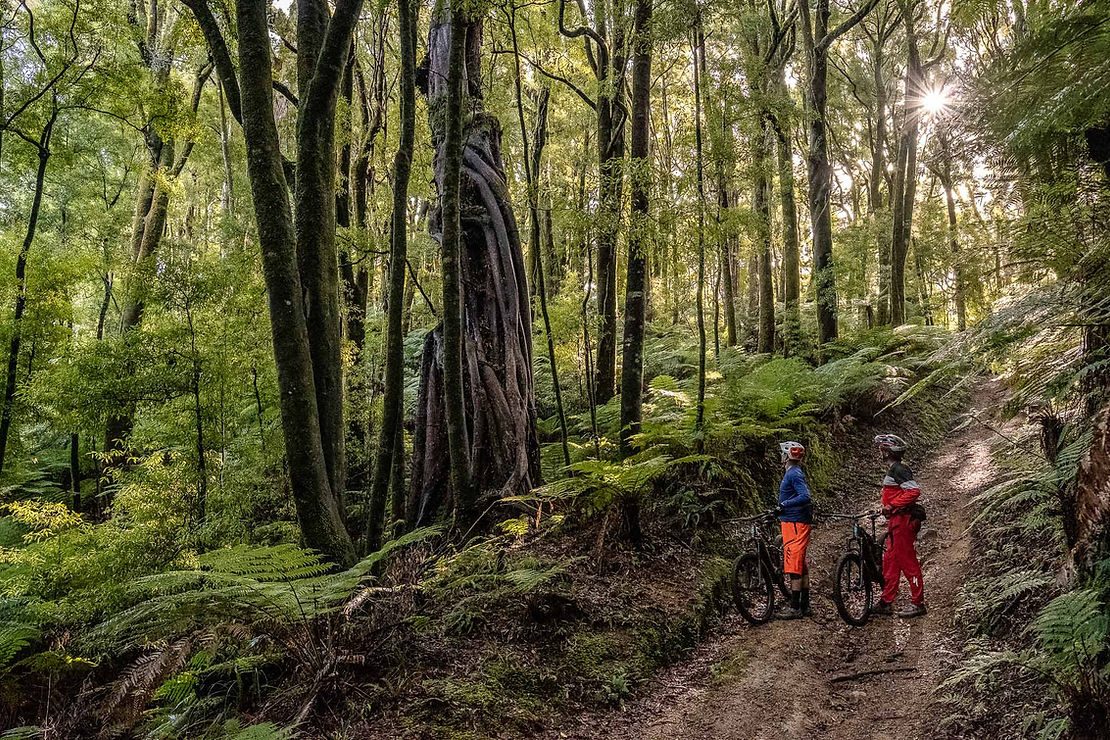
The People
Te Urewera is the traditional home of the Tūhoe people. The Tūhoe signed a deed settling the tribe’s claims at the Waitangi Tribunal negotiations. Of more importance than the fiscal compensation was the fact that the Tūhoe were returned greater control over governance of Te Urewera. This means that in current times the area is administered by the Te Urewera Board, which is a shared responsibility of Tūhoe and Crown entities. The end result of this, is the existence of the Pua a Tane Conservation Park.
Located between Rotorua and Taupo, with extensive ranges of rugged native bush, the appeal for mountain bikers is obvious. A network of well-established tramping tracks and Department of Conservation (DOC) huts date back to the ‘50s, when the primary human interaction with the forest were hunters employed to eradicate deer and other pests. In more recent times Tūhoe and DOC have been leaders in allowing and encouraging recreational mountain bikers to experience what is on offer in the park, with legal access to the Moerangi and Whirinaki trails.
The Critters
When liaising with DOC and Maori landowners as we prepared to complete this ride, we entered somewhat of a rabbit hole when discussing DOC’s role in caring for the area in which the Whirinaki and Moerangi trails reside. Talk turned to DOC’s goal of protecting the whio – NZ’s endangered native blue duck. Neil Hutton, our contact at DOC, passed on an astute observation about the whio: “A lot of New Zealanders have only ever seen a whio on a $10 note… Whirinaki is one of the best places to see whio in real life”.
Stoats have been identified as the primary cause of the whio’s decline in the Whirinaki. Although scientists of the time warned they would be a threat to native birds, stoats were introduced to New Zealand in 1884 to control rabbits and hares. At this stage, I started doing some research into stoats but Google results quickly had me feeling despondent – they’re amazing. Amazingly good at killing, that is. So to curtail their invasive decimation of the endangered whio population is no mean feat.
Since 2011, trapping has played a major part in the improvement of the whio’s long-term fate. Part of my quick research turned up DOC’s info about their trap lines in the forest park – over 1,800 on their trapping lines in the security area.
While simply riding through the trails, the traps are in evidence – sometimes right on the main track. We stopped a couple of times to see if there was a captive stoat in any of them and although the few we saw were empty, they’re obviously only a blip on the radar in the scheme of things with about 1,797 others we didn’t see. Once we ‘got our eye in’ though, we’d often note the presence of trap lines, seeing the markers and the subtle paths leading into the dense bush where the workers lay their traps.
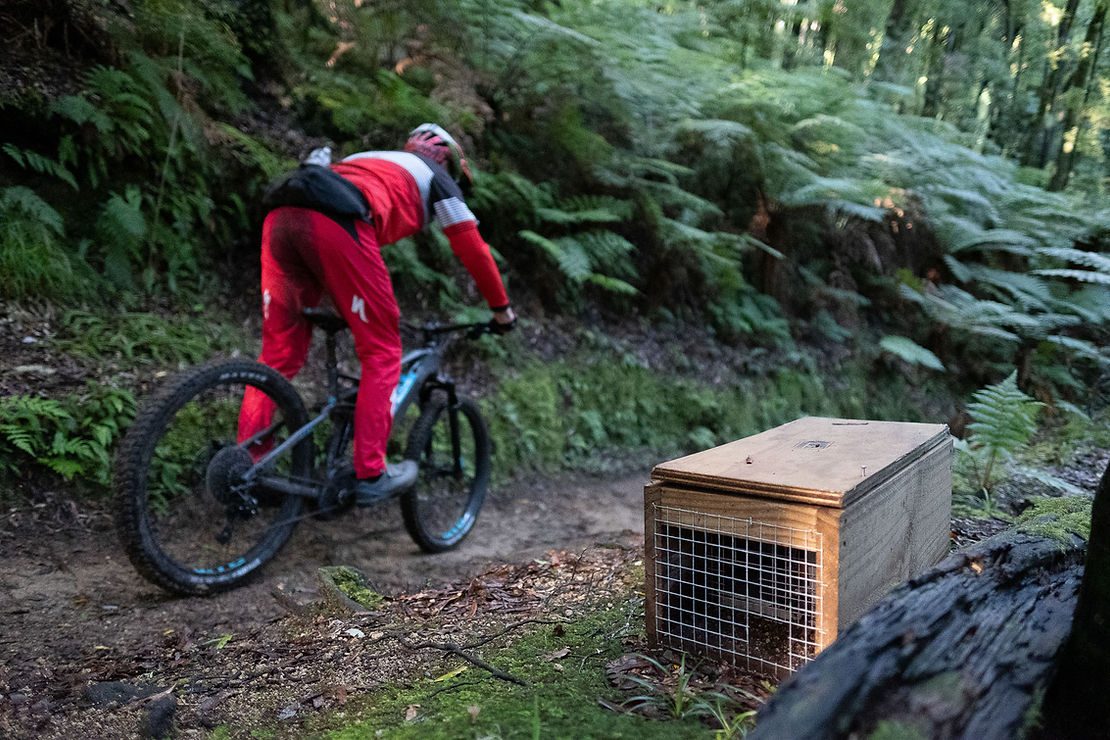
The Journey
The stuff that happens before saddling up to start a ride is all part of the experience, especially if you’re doing it with a sense of adventure, trying new things and going to new places with new riding buddies.
Before even entering Te Urewera, most visitors will come from the more populated northern side of the park – in our case, from Rotorua. The only township of note on the route in, is Murupara, a small town which is effectively the main gateway to Lake Waikaremoana and Te Urewera. Murupara was once an industrious place of extensive forestry, which there are still some remnants of. But like many of New Zealand’s small forest towns, Murupara has experienced hard times with the downturn of labour-based forestry operations in recent years – and there’s little other employment for locals. Our visit to the area included a quick stopover – in anticipation of a lunch break in a few hours’ time – to fill our packs with filled rolls and sandwiches at the local bakery. OK, and there may have been some slices of cake in our orders as well. Oh, OK, yes, some of us may have started eating our cakes before even leaving the car park, but we’re not here to judge each other, are we?!
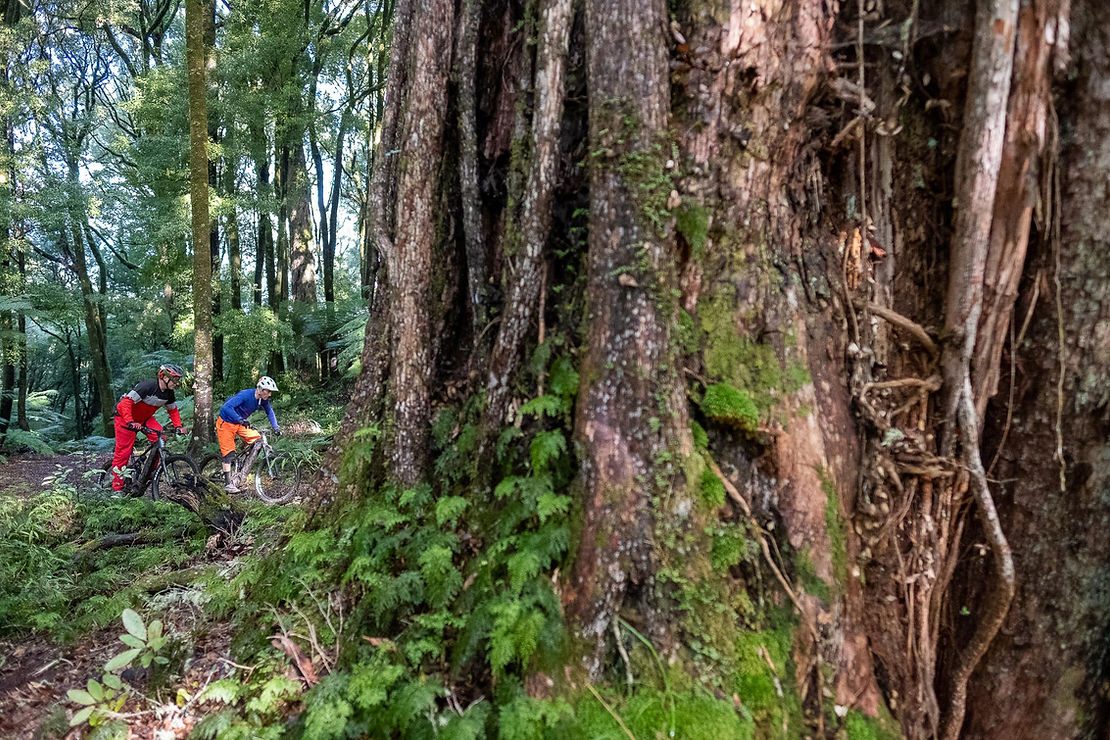
As we were getting the bikes and our gear ready at the trailhead, a large group of trampers arrived. They were a group of disadvantaged youth with ex-army wranglers guiding them through a bush craft exercise. The military leaders obviously had them under their guidance for a while – I’ve never been called ‘sir’ so much in my life, that must be what it’s like to be in the monarchy – though, to be fair, the youngsters also had plenty of comments along the lines of: “Chur, flash bike au”; and the ever-important thing kids want to know: “How much did that cost?”, quickly followed by, “What?! I could buy a car for that much!”
The Ride – Doing it Different
I’ve experienced the Moerangi trail many times, in a variety of ways: on different mountain bikes; doing it as a shuttled loop; riding it as an out-and-back; even bikepacking it on gravel bikes; and doing a heli-drop to the depths of the forest, to do a 30km trail run out.
Every time I’ve been on the Moerangi it has been epic and this time round we found another way to experience it: on e-bikes.
Apart from the nature of the riding itself, one of the notable differences with riding e-bikes is the ability to take more time to stop and look around. Although you can still work hard on an e-bike, you’re arguably fresher than you’d be on a regular bike. That equates to being more inclined to stop and savour the moment, the views and the sounds of the forest. In this case, it was also an opportunity to revisit the Whirinaki mountain bike loop, which is a separate track at one end of the Moerangi trail. I’d only done it once before, many years ago. In recent times, my objective of a day trip to Moerangi was to ride the main trail, either in a shuttled loop or as an out-and-back to as far along the trail as our group wanted to ride.
Riding the Whirinaki loop was great fun and a lot easier than Moerangi. The trail boasts gentler climbs than Moerangi, and there is significantly less elevation so what climbs there are aren’t sustained for long. Mellower gradients lead to less rain-damaged rutting as well, which can be a noticeable feature on the Moerangi, after a series of storms have been through the region.
But apart from the riding experience, the visual and auditory rewards are similar. As soon as we left the car park on the Whirinaki loop trail we were amongst towering podocarp trees – rimu, miro, matai, kahikatea and the mighty tōtara. At ground level the density of lush lime-green ferns is profuse. The heavy rains from the day before our ride adding another degree of vibrant freshness to the intensity of the undergrowth.
At times we Kiwis can take this sort of scenery for granted, especially if we have a primary objective based around a bike ride, and are focused on the ribbon of brown dirt in front of us. It’s when you’re with international visitors that you recognise how truly special New Zealand’s backcountry rides are. Or, as in our case, when we’re out for a good time, not a long time. Plenty of stops for photos meant we had ample opportunity to look around and truly savour the visual extravaganza that the central North Island’s native forest offers.
It’s not all peace and quiet though. At times the birdsong is noticeable and, to be honest, sometimes the piercing alarm calls of the Kaka are jarring – in a good way though. Their shrieks serve to remind us this isn’t our place, we’re merely temporary visitors in the grand scheme of things, and it’s a fitting prompt that beautiful native New Zealand fauna are the original inhabitants of this forest.
Although the Moerangi trail is most often ridden in a clockwise direction via shuttle drop off, I’ve often done it as an out-and-back from the River Road end of the trail. This involves a tough climb with about 600m of vertical gain, which is a correspondingly awesome descent on the return trip.
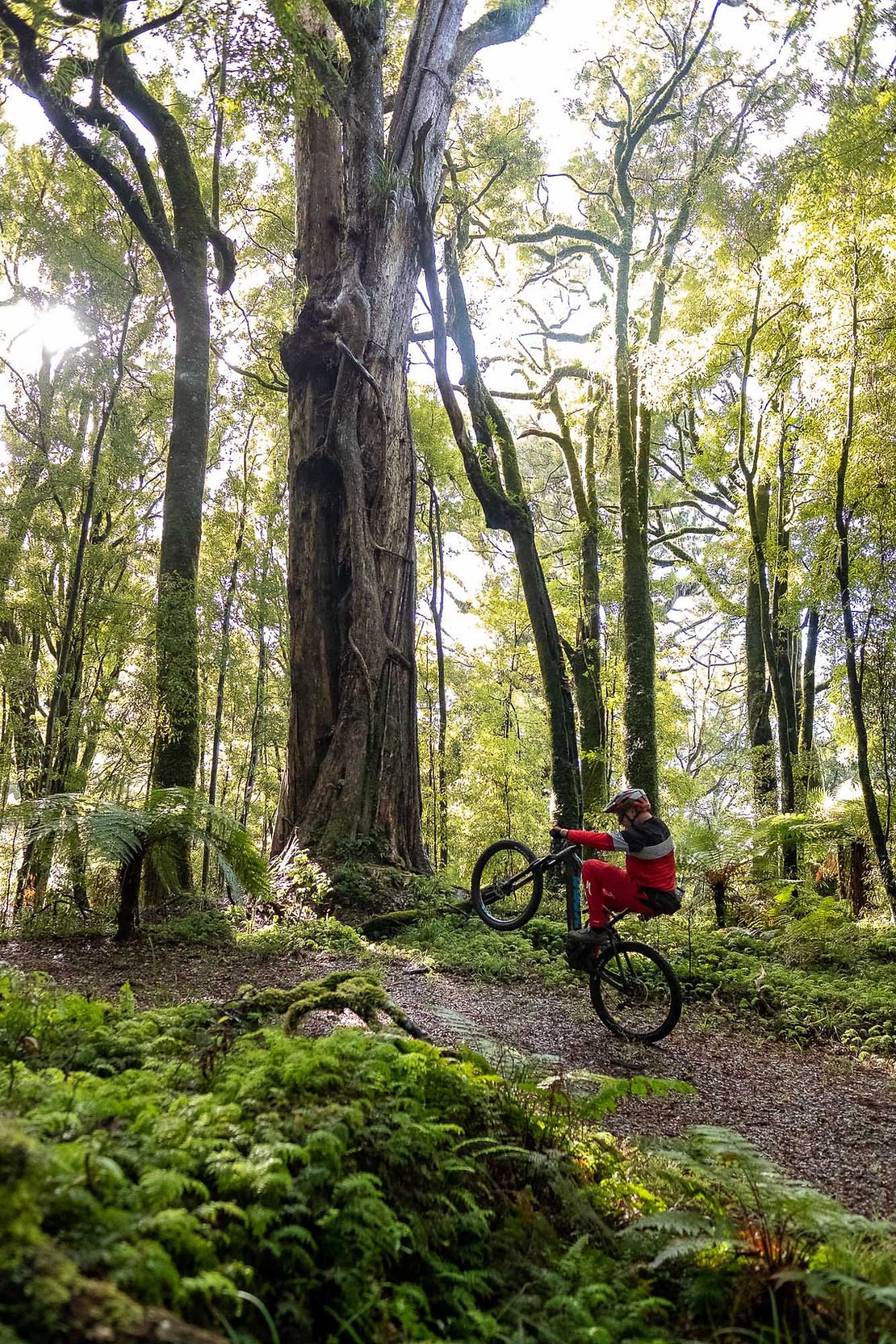
On an e-bike I got to describe the climb as something I never thought I’d say: “It was fun!” We rode every part except one short stretch of soft pumice. I don’t deny I’ve got a real bee in my bonnet with fellow riders who slag off e-bikes without having experienced them. I relish the opportunities they offer both to beginners, or riders with limitations for some reason, and to more experienced, capable riders. In our hands, on this day, we simply enjoyed every single second of riding. Although easily still able to get a solid amount of heavy breathing going on any given climb, the difference from a regular bike was that we were actually riding steep, rutted sections of trail that would quickly have had me walking on my regular bike.
As mentioned previously, I’ve ridden this trail a lot, so am acutely aware of my limitations on any of the technical climbing sections. On the Konas we were still working hard, but in a different way; looking much further ahead on the climbs than usual, because the greater speed meant we’d be coming into whatever was next at a greater pace than on a regular mountain bike. It was also vital to ensure we were in the gearing appropriate to keep a fast cadence throughout whatever we were climbing. Pedal assisted e-bikes simply stop assisting if their cadence/torque sensors sense the rider is only barely turning the cranks over. it’s a weird thing though, the low gearing/high cadence we were utilising effectively on the e-bikes would be completely impractical on a regular bike. On one of those, it’s often desirable to have a slightly tougher gear to crank through over tough obstacles on technical climbs. I’m no physicist (obviously, my wife tells me) but I figure it’s something about torque. All of that is somewhat moot though, because the more you ride an e-bike, the more intuitive it becomes as to what gearing is best for given sections, and how to best utilise the power assist.
The Bikes
I’d be remiss at this point if I didn’t explain a little about the bikes we were on for this adventure ride. Their nature had a significant part in shaping how our ride developed, and the high level of fun-factor we achieved.
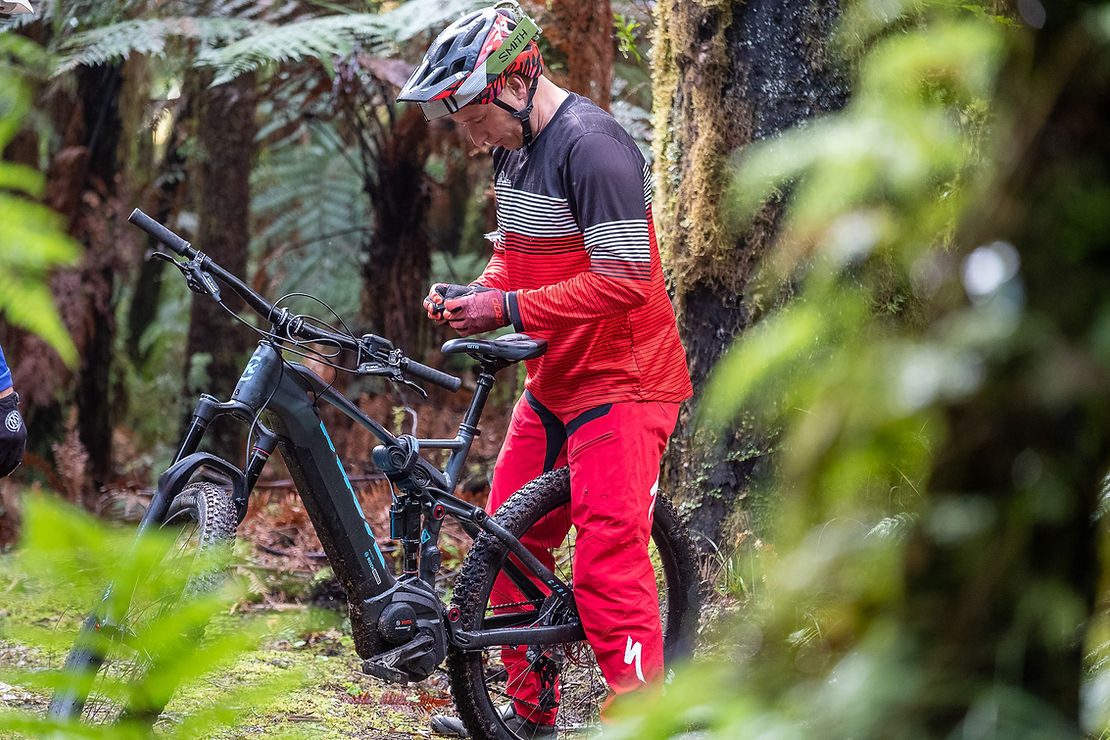
We were on Kona Remote CTRL models – featuring Bosch motors. These slot in amongst the lowest price points for proper, full-suspension electric mountain bikes. I say ‘proper’ to clarify they’re not bicycle shaped objects purporting to be mountain bikes, like many cheap monstrosities for sale on TradeMe.
Sure, at the price of the Konas there are compromises on specs: relatively short travel dropper posts; SRAM Guide brakes instead of Codes, which would be more practical for the speed and weight of an e-bike; and unusual choices for New Zealand conditions, like Maxxis Icon tyres. The Icons are great tyres, for a purpose, but not for those of us who push the boundaries of what is rideable, where traction is king for getting up, down or around any given section of trail. There are plenty of solid performers for critical components though – like RockShox Lyric forks up front and Monarch Plus shocks, with SRAM NX level drivetrain.
Overall, we came away impressed with the bikes. The geometry was on point, the design and construction of the frames was flex free and solid (a particularly important point with heavy and powerful e-bikes). The suspension was tuned appropriately to the rider and bike combo dynamics. To come away with these responses to the capabilities of the Konas, given the remote environs we were riding in, is no small compliment to be dishing out.
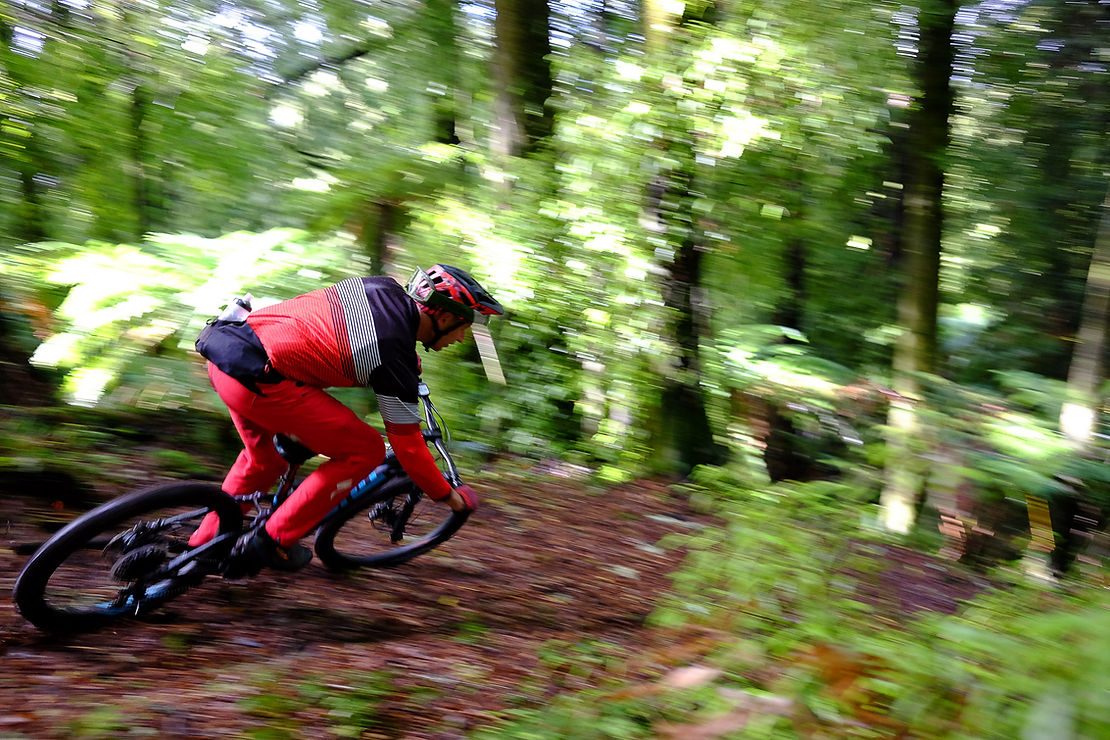
I believe it’s one of those things which is virtually impossible to quantify, but if you did try, it would be along the lines of: “For the lowest-priced, real mountain bike e-bikes available in NZ, we had 90% of the performance possible compared to uber-spendy ebikes upwards of $10k. But, and it’s an important ‘but’, we had 100% of the fun available from what e-bikes bring to rides like this”.
Random Outtakes
Unfortunately, I can tell you from painful experience that it is almost a rite of passage to encounter the native Onaonga plant on Moerangi rides. Although my fellow riders on this trip didn’t get to experience it, I ‘took one for the team’ by taking one step off the trail in the wrong place and getting an instant reminder of what the native stinging nettle Onaonga looks like – and why I should have remembered it from the last time it got its venomous little spikes into me. The skin on my shins is tingling as I write this now – a reminder to pay more attention to look where I’m stepping when I get off the bike to take a photo in the future.
Ah, the serenity. It truly feels like the middle of nowhere most of the time, although we did hear helicopters working occasionally. It’s possible they were tourism operations, hunters or fly fishermen, but it’s more likely – when it’s a busy aircraft flying around for extended periods – they were DOC workers. The recreational users tend to get a drop-off/pick-up and that’s it.
On a previous trip into this area, we spoke with some workmen waiting for their ride into the day’s work site. Their ride was a helicopter. In that instance they were bringing building supplies into the multiple DOC huts in the forest. Those workers also get on the tools to clear the trails which, because of the remoteness and rugged run-off of the terrain, are often subject to weathering from the rain and windfall of storms.
The trails have no views to speak of – not the sweeping vista variety anyway – but the views within the forest are other-worldly, with the verdant greenery of the forest floor and the imposing old-growth native trees putting you in your place.The towering native trees, and the tortuous Giger-like displays of northern rātā gradually strangling their giant host trees, serve as a reminder of how puny we are. (Rata is one of New Zealand’s tallest flowering trees, beginning life as a plant perched on a host tree, high in the forest canopy. Its roots eventually grow down to the forest floor, finally enclosing the host tree and producing a huge tree up to 25 metres high with a trunk up to 2.5 metres in diameter.)
Takeaways
Consider your favourite adventure ride. Can you do it differently? Ride a loop in the opposite direction to usual (if it’s not a one-way trail, obviously); pack a picnic and plan to stop and soak in your surrounds instead of trying to smash out a new Strava PB; take a mate who hasn’t done it before and bask in their enjoyment of it; do it on a different bike if you’re fortunate enough to have a choice. However you do it, there is potential to rediscover and reinvigorate your enjoyment of a trail you know – or at least think you know. As an added bonus, whether you’re South Island based and it’s a major holiday trip, or reside in the North Island and it’s easier to get to – ensure you put the Moerangi and Whirinaki trails on your bucket list. You won’t regret it.
Thanks to Neil Hutton and the team at DOC Whakatane, Earl Rewi and Sharon Nikora of Ngāti Whare and the tangata whenua of Te Urewera.
Check with the Te Urewera DOC office to make sure the trail is open if you’re doing it in winter or when there have been storms in the area – it is prone to slips after heavy rain.
This is a true backcountry ride, so ensure you’re ready for it with suitable gear for trailside bike repairs, and have enough food and water. There is virtually no cell phone coverage to speak of on the trail.
Words and Images: Nick Lambert

